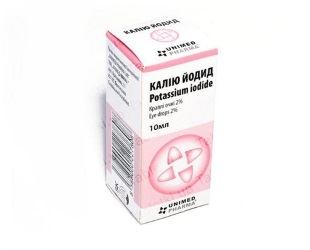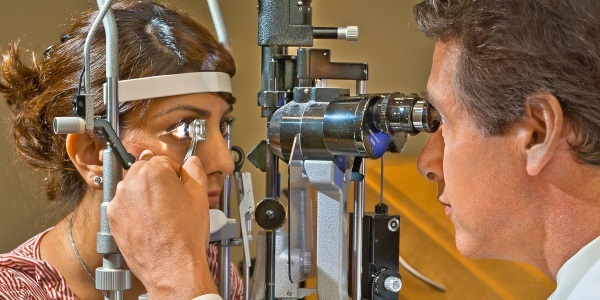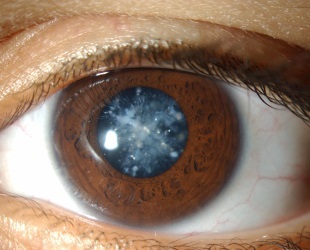
Vision organs are often exposed to different microbes. Harmful microorganisms adversely affect the work of the organs of vision.
To neutralize their influence, ophthalmologists recommend to their patients antimicrobial drugs, which are often produced in the form of drops.
Drops Potassium iodide is considered one of the most effective drugs with antimicrobial effect. They have proven themselves as an affordable and effective tool.
- 1. Instructions for use
- 2. Side effects and contraindications
- 3. Storage terms and conditions
- 4. Price
- 5. Analogues
- 6. Reviews
- 7. Conclusion
- 8. Useful video
Instruction forapplication
Potassium iodide is a medicine that provides antiseptic, antimicrobial, antifungal and antiatherosclerotic effects.
Its application leads to the onset of disappearance of the hemophthalmus, activation of resorption of keratitis elements of syphilitic nature and suppression of fungal growth.

Drops of potassium iodide make the destruction of fats and proteins faster, and also increase the level of lipoprotein in the body.
They contribute to the reduction of blood density, due to which the progression of atherosclerosis is suspended. The use of these drops leads to the expansion of the vascular walls.
The medication accelerates the process of healing of vitreous hemorrhages that can occur in case of susceptibility to hemorrhage, that is, in diabetes mellitus, myopia of a significant degree and arterial hypertension.
Indications for use
This medication is used in the following situations:
- Cataract of any species.
- Bruising in the eye.
- Turbidity of the vitreous corneal body.
- Infections of the conjunctival or corneal zone provoked by the fungus.
- Retinal atherosclerosis.
How to use
Drops Potassium iodide should be used in the dosage that the attending physician selects individually for each patient.
But most often this medication is injected into the lower bag of the conjunctiva of each eye one to two drops from two to four times during the day. The duration of the therapeutic course should not exceed two weeks.
Before using drops, the patient should wash his hands well, so that bacteria do not accumulate on the surface of the vial.
If the patient uses contact lenses, he must necessarily remove them before burying the drops. To install the lenses back is allowed after the of twenty minutes of after the administration of the drug.
When using drops of potassium iodide, it is advisable to gently press down with your finger a portion of the lacrimal sac, which is located in the inner corner of the eye. This will help reduce potential systemic absorption. Remove the finger can be one minute after instillation of the eye.
If you work a lot on a computer, then the following articles will come in handy to save your eyesight:
- Tired eyes from the computer, what to do?
- How to properly instill eye drops?
- Restoring the vision of the house.
Form release, composition
The described preparation is produced in the form of ophthalmic drops, which are a 3% sterile solution. Drops are sold in polyethylene bottles with a capacity of 10 milliliters equipped with a dosing cover.
Each milliliter of this drug contains:
- 30 milligrams of potassium iodide;
- sodium thiosulfate;
- chlorhexidine diacetate;
- sodium chloride;
- purified water.
For sale you can find drops of potassium iodide produced by the plant of LLC "GNTSLS" located in the Ukrainian city of Kharkov, as well as drops made by the Slovak company "Unimed".
Interaction with other
preparationsIf a patient uses medication to get rid of a depressive condition, containing lithium salts, diuretic drugs with potassium-sparing effect, as well as preparations for inhibiting the synthesis of thyroid hormones, he needs to tell his doctor about it.
When combining the described drug with other eye drops, it is necessary to adhere to the of the five-minute interval between instillations.
Side effects and contraindications
In most cases, drops of potassium iodide are transferred normally, but sometimes their use can cause such side effects:
- slight burning sensation immediately after falling into the organs of vision;
- hyperemia and edema of the conjunctival zone;
- enhanced shedding;
- edema of the eyelid and lacrimal gland;
- dermatitis;
- purple;
- of erythema;
- acne;
- worsening of the functioning of the thyroid gland.
Rarely, patients may experience slight blurred vision and impaired attention span within fifteen minutes after the introduction of the described drug.
This fact should be taken into account for those who have to manage road transport.

Overdose
Uncontrolled use of drops Potassium iodide can lead to the accumulation of iodide salts in the body. This phenomenon is called iodism and is determined by such signs as:
- nasal congestion;
- anuria;
- acquisition of oral cavity with a brownish coloration;
- bronchitis;
- enteritis;
- hoarseness caused by swelling of the vocal cords.
Consequences of a severe overdose with this drug can be bleeding in the organs of the genitourinary system and collapse, which can lead to death.
Therefore, if any of the above symptoms appear, you should immediately call a medical team.
If the patient has started bleeding, he should take a horizontal position before the doctors arrive to reduce the amount of blood lost.
In case of an overdose with drops of potassium iodide, rinse the stomach with a 1% solution of sodium thiosulfate with starch, and then use flour flour and a broth cooked from oatmeal or corn.
Contraindications
Contraindications to therapy with the drug Potassium iodide should be called:

- excessive susceptibility to iodine;
- nodular goiter and other tumors of the thyroid gland that have a benign course;
- of kidney inflammation;
- thyroid adenoma of toxic type;
- diathesis of hemorrhagic type;
- the presence of acne on the skin;
- pyoderma;
- furunculosis;
- is under the age of eighteen.
Before prescribing drops of potassium iodide to a patient, the doctor should carefully examine his condition, in particular, diagnose the thyroid gland.
If it turns out that the thyroid gland has malignant lesions, it is impossible to use the given drops to the patient.
In pregnancy,
For women who are carrying a baby, the described drops can only be recommended if they are careful.
Storage conditions and storage times
Store the above described preparation at room temperature in dark places, hidden from young children. The drug should not be subjected to freezing.
After first use, potassium iodide should be used within one month.
Price
| Average cost in Russia | 190 rubles |
| Average cost in Ukraine | 50 UAH |
Analogues
Analogues of drops of Potassium iodide can be called the following medicines:
- Stilavit, which forms a film on the visual organs, protecting them from the adverse effects of external factors;
- Xalatan, containing latanoprost and having anti-glaucoma effect;
- Timolol-pos, reducing intraocular pressure;
- Dexona, which reduces inflammation and increases the resistance of the organs of vision to harmful substances;
- Phloxal, which prevents bacterial infection and promotes the treatment of inflammation of the eyes;
- Tevodex, acting on the basis of antibiotic toramycin and glucocorticosteroid dexamethasone;
- Albacid, which has a bacteriostatic effect.
Reviews

Most patients responded about drops of potassium iodide positively.
They claim that this drug leads to an early resorption of bruising in the eyes, which occur for various reasons.
In addition, drops of potassium iodide help stop the development of the fungus and prevent a new infection.
The main advantages of this drug patients call affordable cost and ease of use.
Some people claim that they had to face some discomfort in the field of vision in the process of using drops of potassium iodide. However, if this side effect is the only one, then it is not an excuse for refusing treatment with the described drug.
At the end of the article, you can see the responses that real patients have left about using drops of potassium iodide.
Conclusion
- Potassium iodide is a drug with antiseptic effect.
- It is produced in the form of ophthalmic drops and is used for the treatment of eye ailments of various nature.
- Drops Potassium iodide is not allowed to be used to treat children, as well as patients with certain diseases.
- Pregnant women can use these drops exclusively for the doctor's prescription and under his strictest control.
- In rare cases, the use of drops of potassium iodide can result in undesirable side reactions of the body.
- Categorically not allowed to exceed the prescribed dosage of this drug and the duration of treatment.
- In pharmaceuticals, there are drugs that can be a substitute for the aforementioned droplets.
- Drops of potassium iodide are affordable and enjoy a good reputation in patients.
